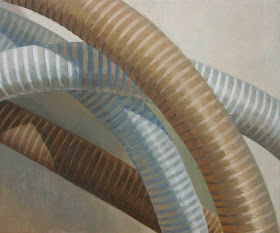When I began to work on this painting I had something like a minor fit of anger towards it: "No, no, I don't want to deal with this, with this level of detail." I planned to set it aside, wipe it out, and began a very lively discussion on facebook about abandoning work that you've begun, which you can see here if you're interested.

The work started well enough: I liked the composition, the overlap of curving forms with minimal color. I always start my paintings with a very loose underpainting, and develop the form, color, and detail from there. I have to admit that I had no idea how I was going to move forward with this painting; how in the world was I going to tackle all those lines on the hoses? I couldn't just leave them out because they're a key to the energy of the image. So, when I got back to work the next day, I first started getting the forms in the right place and correct proportion, but the thought of the detail sent me into something of a nervous breakdown. I felt like throwing the panel across the room, but instead set it aside, and began to work on something else, the painting Middle Squiggle.
One friend, on the facebook thread, commented that it sounded like I needed a day off. When I thought about this, I remembered how I had a similar feeling while cutting back a flower border: "I don't want to do this! I want to be doing something else, like painting!" A couple of days went by and when I went back out to the flower border, I was determined to enjoy what I was doing then, to accept the moment and not bemoan it. It made a huge difference in my feeling of pleasure, so once I finished Middle Squiggle, I looked again at Overlap and saw that I could complete it, if I calmed down and approached it with patience.

What I finally understood was that I had to think about light, rather than detail; light would be the essence of the painting. Once I realized that, things went more smoothly. First I painted the wall behind the hoses, putting layer upon layer of warm and cool, darker and lighter color, until the surface looked like a solid plane and had weight and a presence in space. Using some warmer color in the highlights gave an added sense of luminosity.

I was determined not to measure the lines in the hoses, but to paint them freely, eyeballing the distance between them; the most important thing was the quality of light, created by the relationships of color and value. I painted the lines in lighter paint, then painted over them, as part of the entire columnar form, again and again, changing color, making it lighter or darker, so as to get the sense of opaque and transparent light. Because egg tempera is a translucent paint which dries immediately, it lends itself beautifully to this kind of handling. I wish I'd made the image a little larger, but I'm glad I pushed through with the painting, learning something along the way.

this worked out so well. I have seen you working out this idea in in recent paintings and I knew you would find an excellent resolution.
ReplyDeletewonderful.
wonderful resolution, terrific painting Altoon.
ReplyDeleteWould you be comfortable with a description of this as "a highly sensitive 're-presentation" of your visual experience from a fixed point of view in a moment frozen in time?"
thanks, surrounded and steven.
ReplyDeletesteven, I don't think that quite gets what I'm doing because my visual experience develops as I'm working on the painting. It is not frozen I hope, or a moment; it's an accumulation of process and perception, taking place over time. It is a fixed point of view, though, as far as drawing goes. (whose quote is it?)
I want to see these in person. So beguiling. Thank you for posting these images Altoon.
ReplyDeleteslowmuse, thank you. I'll certainly let everyone know if I ever have a show. It is a very different experience standing in front of an actual object than seeing it flattened on a screen. These paintings can be especially deceptive because they're so small.
ReplyDeletewonderful sense of translucence - your wrestle with this painting did you good!
ReplyDeletethanks, rappel; I'm glad I was able to continue with it.
ReplyDeleteI also am glad to see this, and to hear how you resolved it -- I like to look at how the light falls on each hose in different places.
ReplyDeleteSusan Sawyer
thanks so much, Susan.
ReplyDeleteIt's wonderful to hear about your process and struggle with yourself as you worked on this. It turned out very well.
ReplyDeleteIt turned out wonderfully, Altoon. Congratulations!
ReplyDelete